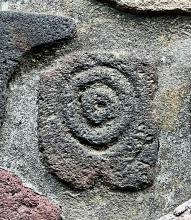quiyahuitl (Mdz8r)
This element, with the phonetic value of quiyauh-, from the noun for rain (quiyahuitl) derives from a compound glyph for the place name Quiyauhteopan (the version on folio 8 recto of the Codex Mendoza). It has three vertical symbols of water falling from the sky with a drop at the bottom of each one. Each of the three drops at the bottom of the streams consists of two concentric circles, and they are not colored. The falling water is, not surprisingly, painted turquoise blue and black lines provide a suggestion of some current in each flow. At the top, the flow stops as though broken off. They fall from an unknown source, as though suspended in air. The arrangement of the streams of water is symmetrical.
Stephanie Wood
The staggering of these raindrops at different heights provides a type of visual movement, as though they are falling through the air.
In the compound from which this element has been carved, the rain falls onto the top of a temple (teopan). The visual relationship between rain (quiyahuitl) and water (atl) is not a coincidence. Variations will occur, but this is a classic representation of rain, and we have a few compound glyphs in this collection that indicate the importance of rain. As our online Nahuatl Dictionary entry for quiyahuitl shows, there was a strong relationship between tears and raindrops. When children cried, people believed that to be a sign that it would rain. Rainfall had a strong association with the deity or priest called Tlaloc, who could bring on the rain and facilitate fertility in agriculture (Florentine Codex, Book 1). Tlaloc wore a necklace of green stones, which also symbolized water or precious raindrops.
Besides the fact that rain is essential for agricultural success in many parts of the Nahua world, and probably because of that, the term quiyahuitl is a day name in the 260-day divinatory calendar, the tonalpohualli, and therefore has religious significance.
Stephanie Wood
c. 1541, or by 1553 at the latest
Stephanie Wood
Crystal Boulton-Scott
rains, rainstorm, heavy rain, waters, agua, aguacero, lluvia
This example of two concentric circles that stand alone are reminiscent of drops of water. The glyph for rain, above, has three such droplets at the bottom of short streams of water. These concentric circles carved in stone appear on the side of a pyramid at the archaeological site at Tlatelolco. The stone might not be in its original location, due to reconstruction. Photo by S. Wood, 2 May 2025.

quiyahui(tl), rain or rainstorm, https://nahuatl.wired-humanities.org/content/quiyahuitl
a(tl), water, https://nahuatl.wired-humanities.org/content/atl
rain or rainstorm
la lluvia, o una tormenta de lluvia, o un aguacero
Stephanie Wood
Codex Mendoza, folio 8 recto, https://digital.bodleian.ox.ac.uk/objects/2fea788e-2aa2-4f08-b6d9-648c00..., image 25, of 188.
The Bodleian Libraries, University of Oxford, hold the original manuscript, the MS. Arch. Selden. A. 1. This image is published here under the UK Creative Commons, “Attribution-NonCommercial-ShareAlike 3.0 License” (CC-BY-NC-SA 3.0).





